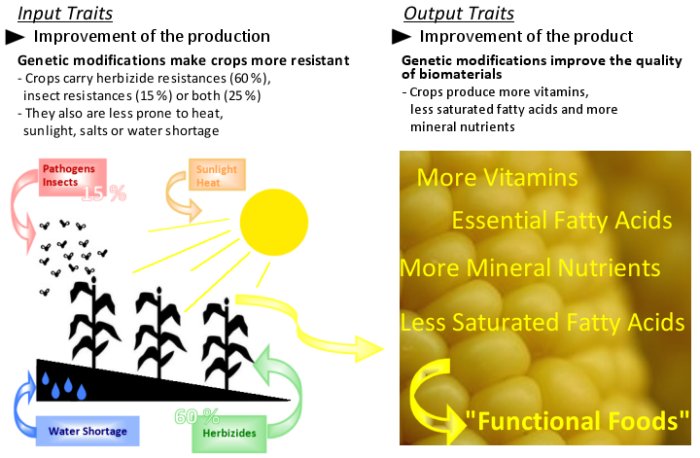Describe the Most Common Desired Traits Used in Gm Crops
In Canada 98 of the canola crop is GM. Examples of GM crops include corn varieties containing a gene for a bacterial pesticide that kills larval pests and soybeans with an inserted gene that renders them resistant to weed-killers such as Roundup.
/cdn.vox-cdn.com/uploads/chorus_asset/file/6501175/Screen%20Shot%202016-05-17%20at%208.17.06%20PM.png)
5 Big Takeaways From The Most Thorough Review Of Gmos Yet Vox
GM crops are regulated at the federal level by the US.
. Examples are purple tomatoes and pink grapefruit with increased levels of antioxidants and golden rice which is engineered to reduce vitamin A deficiency. Largest acreage GM crops. These benefits are a plus for both farmers and consumers.
Resistance to an herbicide. Increased Flavor and Nutrition Along with resistances to insects and disease the genes of the crops can also be altered to have a better flavor and increased nutritional value. To produce a GM plant new DNA is transferred into plant cells.
Another category of GE crop traits is improved nutritional content or health benefits. Genetically engineered crops produce higher yields have a longer shelf life are resistant to diseases and pests and even taste better. Genetically Modified GM crops offer improved yields enhanced nutritional value longer shelf life and resistance to drought frost or insect pests.
Today approximately 90 percent of the corn soybeans and sugar beets on the market are GMOs. Genetically modified GM plants. This is good all around.
For example rice canola and tomato crops have been genetically modified to increase their tolerance to salt stress. Herbicide-tolerant GM crops have been widely adopted in the US such that 90 of corn soybeans and cotton are GM and herbicide-tolerant 28 and as other countries adopt GM technologies the amount of acreage planted with herbicide-tolerant GM crops will continue to grow. The seeds produced by these plants will inherit the new DNA.
For example one of the most common GMO crops is Bt corn which is genetically modified to produce the insecticide Bt toxin. This was the main goal of GMO crops in the first place. GM soybean maize canola and cotton are the most common examples of these crops in the market James 2014Developing countries like India and China are the largest producers of genetically modified Bt cotton Markoulatos et al.
GM crop technology has improved yields through improved control of pests and weeds. In 2011 167 million farmers grew. About 1917 million hectares was planted in 2018 to transgenic crops with high market value such as herbicide tolerant soybean maize cotton and canola.
GM can only be used to introduce a new characteristic into. With genetic engineering more than. Potential future applications of the technology include nutritional enhancements stress tolerance disease resistance biofuel efficiency and remediation of polluted sites.
Modern genetic methods of crop improvement are responsible for a significant fraction of the recent yield increases in crops where they are used so farmers who have adopted GM crops have benefited the most. Transgenic crops have been planted in different countries for twenty years starting from 1996. For example insect resistant IR crop technology used in cotton and corn has between 1996 to 2018 across all users of this technology increased yields by an average of 165 for IR corn and 137 for IR cotton relative to conventional production systems.
As of 1999 the most prevalent GM trait was glyphosate-tolerance. GM crops are varieties produced through introduction of pieces of DNA to give them specific desired traits eg resistance to certain insects herbicides and viruses. The Golden rice is one of the oldest GM crops in the world and the last one on our list of 10 examples of genetically modified foods with full.
Usually the cells are then grown in tissue culture where they develop into plants. A New trait might help in. The most widely accepted genetically modified traits in GM crops are herbicide tolerance and insect resistance.
Insect resistant maize cotton potato and rice. New characteristics can be introduced into crops using either conventional or GM approaches. GM crops grown in Colorado include corn alfalfa sugar beet soybeans and canola.
This raises the question of when a plant breeder might choose a GM approach vs a conventional approach. Indeed most of what people believe about GM crops is the exact opposite of what is true. Genetically modified crops GM Crops or Biotech Crops They are the plants used in agriculture whose DNA has been modified to induce a desired new trait.
Controlling certain pests diseases or environmental conditions reduction of spoilage inducing resistance to chemical treatments eg. And virus resistant squash and papaya. By making this toxin the corn is.
These crops are not available at this time but could be available in the near future. GM is a technology that involves inserting DNA into the genome of an organism. Longer Shelf Life Genetically modified foods have a longer shelf life.
Only a few types of GMO crops are grown in the United States but some of these GMOs make up a large percentage of the crop grown eg soybeans corn sugar beets canola and cotton.

Genetically Modified Gm Crops Techniques And Applications 0 710 Extension

0 Response to "Describe the Most Common Desired Traits Used in Gm Crops"
Post a Comment